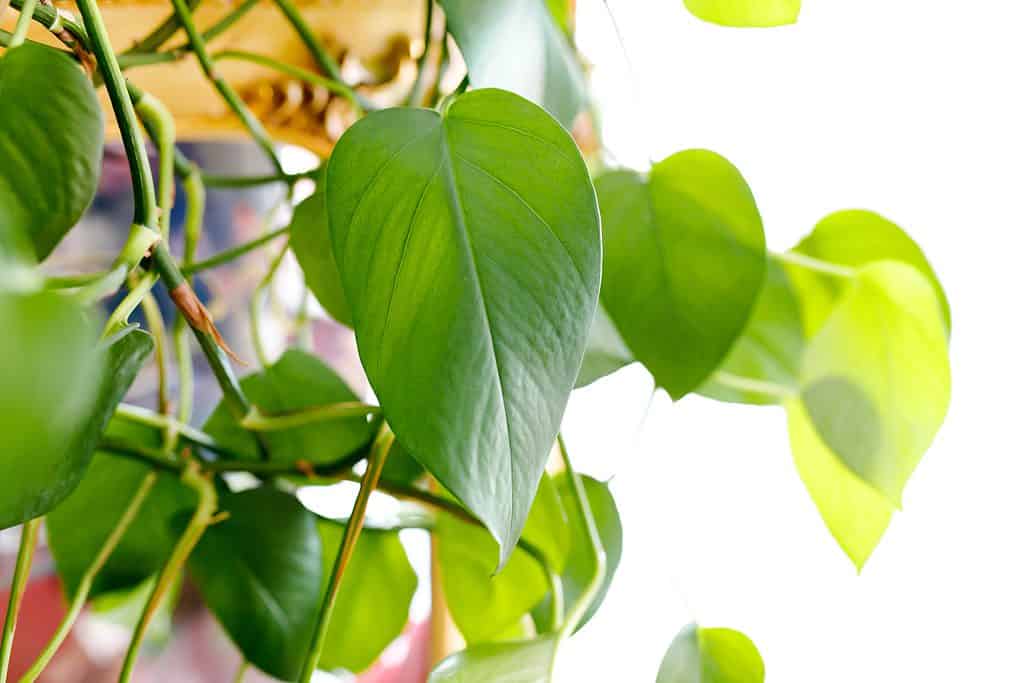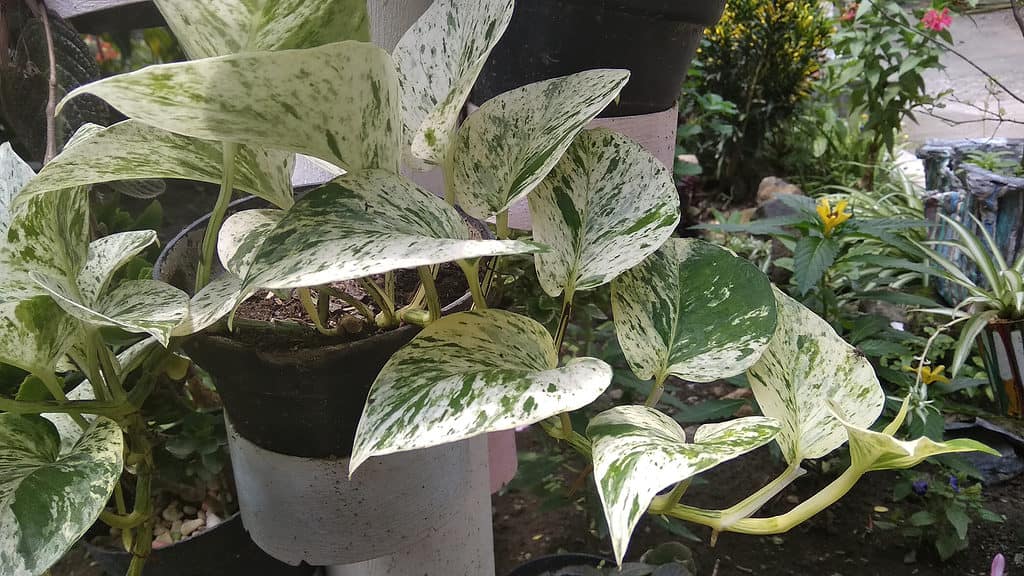The pothos plant is a must-have for novice and seasoned plant owners alike, and this plant can be found in practically every home of a houseplant enthusiast worldwide. In addition to its coveted trailing tendrils and extraordinary simplicity of maintenance, pothos plants have a wide range of other benefits and advantages. There is no excuse not to like the loveable pothos!
In this guide, we’ll explore all of the many benefits of owning a pothos plant inside your home. Some of these benefits might just surprise you.
1. They Are Easy to Maintain
Pothos will be at the top of any list of indoor plants that are easy for beginners to care for. These plants can withstand pretty extreme neglect and flourish in virtually any indoor setting. Even when put through adversity, they retain their fresh appearance. A pothos may be planted almost anywhere that has enough light for it to survive. That being said, pothos plants can’t tolerate complete neglect. They do need occasional care, as well as specific temperature and humidity requirements. However, those requirements are easy to provide.
The pothos is not bothered by a few missed waterings and does not require extremely high humidity levels to maintain its shine. These plants need little more than enough sunlight, water, soil, pruning, and sporadically applied fertilizer to thrive. They may be placed almost anywhere in your home or office, and their lovely vines will grow quite quickly with minimal attention. You should think about repotting your pothos into a bigger container every year or two, but that’s the extent of what they really need.
2. They Are Very Hard to Kill
Pothos are extremely resistant to the majority of pests and illnesses in addition to being low-maintenance plants. Along with the well-known hoya and the rubber plant, they are included in the group of plants that are virtually impossible to kill. They won’t change in appearance for weeks on end if you leave them to their own devices and forget about them.
It’s worth noting that despite how fine they appear, they are not necessarily prospering or even just surviving. Pothos shouldn’t be abandoned or neglected for extended periods of time. But the pothos won’t punish you if you do happen to accidentally forget about them while on vacation. Signs of neglect on the pothos plant include yellowing leaves or leaf loss, which are excellent signs that your plant needs a bit more care than it is getting currently.

Pothos leaves (pictured) will stay vibrant and healthy even with minimal attention.
©Lifesummerlin/Shutterstock.com
3. They Can Clean the Air in Your Home
The well-known NASA Clean Air Study is frequently referenced online. In order to potentially deploy houseplants in space stations, researchers examined their capacity to remove volatile organic compounds (also known as VOCs) from the air. The common pothos participated in this study and showed promising outcomes in the removal of a number of dangerous substances from the air.
Pothos outperformed all other substances evaluated in its capacity to eliminate benzene, formaldehyde, and other toxins from the air. Despite not having trichloroethylene or ammonia removal systems, they outperformed a lot of other houseplants in the study, including the closely related climbing philodendron.
Although this study’s methodology was solid, it has been disproven for usage at home over time. In a limited area, you would need hundreds of plants to get the same results. But even a small number of plants will have some advantageous benefits for your home. Additionally, because they are so simple to reproduce, you can always grow more to get the benefits of cleaner air inside your home.
4. They Can Handle Low Sunlight
Indoor lighting is difficult to control. Finding the ideal balance of bright indirect light, which most houseplants enjoy, can be challenging especially if you need to squeeze several plants into a small space. The pothos enters the picture here as one plant you won’t have to fuss about. These plants thrive in almost any lighting situation, so much so that they are frequently referred to as “zero light” plants. However, that is not necessarily true. All plants need at least some sunlight, and your pothos will need at least something to keep them alive. That being said, these plants will continue to flourish whether they are put in a low-light area of your kitchen or a sunny spot in a large east-facing window.
Remember, it’s important to understand that just because they can tolerate low light circumstances exceptionally well doesn’t guarantee they will thrive there. Low light is not a problem if you’re happy to retain your pothos at their current size. Bright and indirect light works best if you want your plant to grow large and have more vibrant foliage.
5. They Can Increase Indoor Humidity
Because viruses can’t spread readily in moist air, humidity helps protect you against the common cold and influenza. It also keeps your skin moisturized and in some cases can help us breathe better. Dry air, on the other hand, intensifies airborne contaminants, dust, and allergy responses. It’s good to know that the pothos plant is capable of raising humidity levels surrounding it. Because pothos plants need regular watering and occasional misting to provide them with a good amount of humidity, that humidity will be present in your home and will build up over time as you continue to propagate or collect more pothos plants.

Pothos (pictured) require lots of water, which will boost the humidity in an indoor space.
©iStock.com/Suprabhat Dutta
6. They Don’t Actually Need Soil to Grow
Pothos plants can easily grow in water alone for a lengthy period of time and are extremely easy to propagate in water. It is possible to let your own pothos stems propagate in water for longer than the couple of weeks necessary to form sturdy roots, even if this is not as simple as putting the stem in a glass of water and forgetting about it. Your pothos can’t live forever in water, but it will survive and grow roots for quite a while.
These pothos plants that are grown in water will just need a couple of applications of liquid fertilizer added every two weeks for upkeep. The healthiest roots may be maintained by doing a thorough water change every few days or a daily water top-off. These plants may continue to grow in an uncontaminated, clean jar for several months as long as the water has enough nutrients. Use a transparent glass jar or vase to see the roots develop so that you may turn your propagation efforts into healthy, established plants.
7. They Are Great Plants for Feng Shui
You’ll adore the pothos even more if you’re interested in Feng Shui, the practice of creating balance in living spaces. This very symbolic plant is claimed to clear out negative energy from empty rooms in homes. You can put it on top of a cabinet or in a dim corner to boost the energy in those spaces and the overall energy balance in your house because it can flourish in reduced lighting circumstances.
Pothos is also said to bring luck and wealth in some areas. One of its many popular names is the money plant, which is utilized in conventional Feng Shui to promote financial wealth and success. For the benefits to manifest, it is customary to place the pothos at the southeast corner of your home.
8. They Are Easy to Propagate
It’s easy to understand why propagating is a common hobby for parents of indoor plants. You can easily grow more of your priceless pothos plants for free by propagating them via plant cuttings. A good pair of sterilized scissors and a few minutes of your time are all that is needed to get started with plant propagation. Plus, the procedure couldn’t be simpler when it comes to pothos.
Propagation from stem cuttings is extremely straightforward since pothos plants have long stems that climb objects and trail over fences. Cut a section of the vine about four inches long right below a leaf node. Leave at least two leaves at the top of the cutting after removing the leaves from the bottom half. Your cuttings should be rooted in a glass of filtered water or a soil-propagating mixture. Within a few weeks of care, they will begin to develop roots. At this point, they might be gathered and transplanted to create a brand-new potted pothos plant. How easy is that?
9. They Can Benefit Your Mental Health
Did you know that being among plants makes us happier? An activity known as “therapeutic gardening” was developed as a result of scientific research that demonstrated the advantages of plants and nature for mental health. Interacting with the natural environment has a favorable effect on our attitudes and moods, which ultimately makes us happy.
Pothos plants are likewise entitled to these advantages. One study explicitly examined the advantages of interacting with pothos plants. Even though the study’s participants couldn’t physically see the plants while they were touching them, they quickly discovered that just by stroking the leaves, they experienced a sense of relaxation. Numerous studies, like this one, demonstrate how deeply embedded our relationship with nature is. Thus, by keeping pothos plants and other houseplants in your home, you can give your overall well-being a big boost.

Pothos plants (pictured) come in many colors and sizes, all of which can be beneficial for one’s mental health.
©Rezqiano/Shutterstock.com
10. They Look Stunning
We had to include the pothos plant’s stunning looks in this list of benefits! Pothos may be coaxed to grow on practically anything, as it is a trailing plant. This plant has the special ability to be either a trailing houseplant or a climbing houseplant, depending on your personal aesthetic preferences. Just as well, unlike other similar houseplants, it doesn’t lose its luster in the absence of sunshine. The heart-shaped, variegated leaves are green and brilliant yellow, and they have a waxy sheen that makes them appear appealing. There are many different varieties of pothos that boast different colors and variegation as well.
Pothos is a flexible plant for decoration since you may teach it to grow in any direction you choose. You may put it on a shelf, a desk, a bedroom side table, or a kitchen counter, or you can hang it from a window with the stems flowing downward. Additionally, you may train it as a loop or any other shape. You can really do a lot with the versatile pothos!
There are truly so many reasons to enjoy the beautiful and easy-to-grow pothos. Why not keep one (or two, or three!) in your own space?
Want to learn more about the eye-catching pothos houseplant? Check out our in-depth guide to everything you need to know about pothos!
The photo featured at the top of this post is © Firn/Shutterstock.com
FAQs (Frequently Asked Questions)
Can pothos plants purify the air?
Yes. Pothos plants can purify the air and reduce toxins such as formaldehyde and benzene from indoor spaces.
Are pothos plants poisonous?
Unfortunately, pothos plants are toxic, especially to pets.
Do pothos need a ton of light?
Pothos are known for being quite tolerant of very low light.
Thank you for reading! Have some feedback for us? Contact the AZ Animals editorial team.






